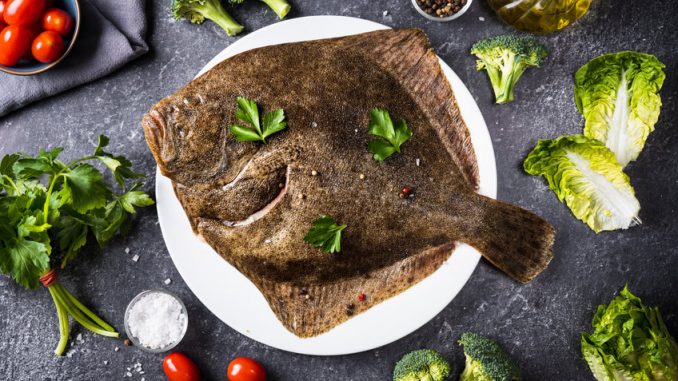
Halibut is one of the classy fishes found on the restaurant menu. It is noted for its delicate and slightly sweet flavour.
The halibut is a typical flatfish and one of the largest. Both eyes are on the same side of the body because it lives on the ocean floor. The common name actually refers to flat fish in the order Pleuronectiformes. Most commercial fishermen catch the Pacific halibut (Hippoglossus stenolepsis) which is common throughout the Pacific ocean. Since 80% of the catch comes from waters in and around Alaska it is often called Alaskan halibut.
One of the best methods of cooking is to bake halibut in the oven. It is a simple method for preparing this great fish and is versatile in terms of the types of sauces that can be served with it. Simple sauces work especially well with it including rich butters and fish or sea-mollusc based dressings.
The alternative cooking methods are to roast the fish as opposed to baking it so that more of the flavour of the skin is brought out, to grill and to pan-fry like a steak. All these methods create their own particular flavour. Beware of overcooking this fish!
To bring a halibut dish alive requires other components. If you serve the size of piece suggested below then make sure there is plenty of sauce. Typical flavoursome additions such as garnishes include buttered poached scallops, and mussels which can be steamed in cider for really seafood flavour. A good sauce might be a brown butter but if there is any coral left from the scallops or any other bits of seafood left over then these can all be brought together to make a powerful sauce. For vegetables, create a mound of pressed greens to sit the halibut pieces on and plenty of herby potatoes. Immediate thoughts go to Parmentier which is ideal because these are easy to make and have a delicate, slightly punchy note. Use complementary herbs like thyme or rosemary infused through them. It does enough without causing the halibut to lose its identity on the dish.
Ingredients for a Baked Halibut:
- 1 tablespoon of olive oil, with more for the pan
- 2 cloves garlic, finely minced (optional)
- ½ teaspoon salt
- 2 fish fillets about ½-inch thick. Ask the fishmonger to keep any skin on because it helps with flavour development and keeps the flesh together.
- pinch of salt and pepper
Preparation:
- Heat oven to 375ºF/190ºC.
- Line a baking dish with parchment paper or aluminum foil.
- Drizzle a small amount of oil on the prepared baking dish. Place the fish fillets on top and season each fillet with salt and pepper, and garlic. Wrap more foil or parchment over the top so that during baking it does not dry out.
- Bake the fillets for 20 minutes or until the fish is cooked through, serve immediately. To get a crispy skin, take the top off about 5 minutes before the end of the cooking. It’s also a good point in time to see how the fish has been cooking in the baking dish.
- Keep a watchful eye on this fish as it bakes because it will suffer from being overcooked and losing its moist texture in an instance.
Some additional ideas would be to serve the halibut using potato slices which have been layered over the fish whilst it cooks. The potato slices then contribute to the dish as a side instead of separately making another side of potatoes.
Pressed Greens
A base for pieces of any fish is pressed greens which simply means leafy greens such as spinach and leek. To make a good base, take a few leeks and chop roughly. Cook in butter for about 5 to 7 minutes. Then add a large portion of leak and wilt in the heat with the leeks. All the water will get squeezed out of them as it cooks briefly. The moisture can be squeezed out with a wooden spoon. Place these in a metal cookie cutter or a hollow ring on the serving place and shape. Add the pieces of fish on top.
Leave a Reply